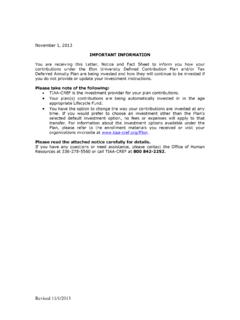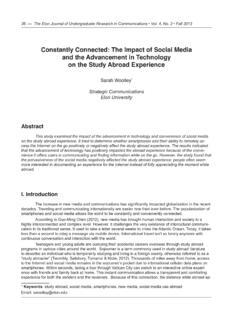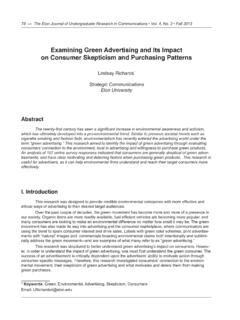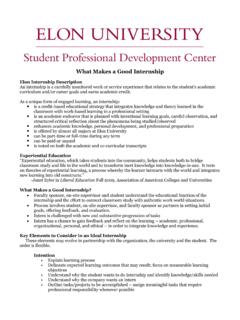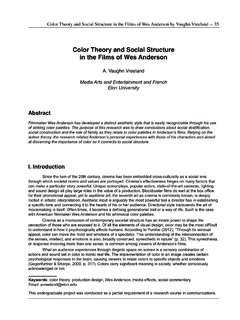Transcription of The Effect of Technology on Face-to-Face Communication
1 The Effect of Technology on Face-to-Face Communication by Emily Drago 13. The Effect of Technology on Face-to-Face Communication Emily Drago Strategic Communications Elon University Abstract Recent technological advancements have had a drastic impact on the way individuals communicate. In this research, previous studies were analyzed, field observations were conducted, and an online survey was administered to determine the level of engagement individuals have with their cell phones, other technolo- gies and with each other in Face-to-Face situations. Findings suggest that Technology has a negative Effect on both the quality and quantity of Face-to-Face Communication .
2 Despite individuals' awareness of the decrease of Face-to-Face Communication as a result of Technology , more than 62% of individuals observed on Elon's campus continue to use mobile devices in the presence of others. I. Introduction Celebrity couple Kristen Bell and Dax Shepard star in a recent Samsung Galaxy Tab S ad that follows them on a day in their lives repeatedly distracted by Technology . The couple decides to ditch their plans to go hiking and, instead, spend the day completely attached to their tablets. The commercial highlights the couple playing games on their separate devices at dinner, video chatting each other from different rooms in their house, and missing a black-tie event to watch a movie on their tablet instead.
3 While it seems as though this should be a PSA promoting Face-to-Face interaction rather than screen-to-screen, it is just another ploy to sell more Technology . This ad, along with many others, has emphasized the fact that as the use of devices and Technology that allow people to communicate digitally increase, Face-to-Face interaction decreases. Little by little, Technology has become an integral part of the way that people communicate with one another and has increasingly taken the place of Face-to-Face Communication . Due to the rapid expansion of Technology , many individuals fear that people may be too immersed in this digital world and not present enough in the real world.
4 In reaction to the overwhelming replacement of face time with screen time, a Mas- sachusetts family decided to implement an Internet Sabbath each weekend in which no video games, com- puters or smartphones can be used. The father, William Powers, expressed the difficulty of the weekly detox stating, It almost had an existential feeling of, I don't know who I am with the Internet gone.' But after a few months it hardened into a habit and we all began to realize we were gaining a lot from it (Adler, 2013). Many others have expressed shared concerns regarding the overuse of Technology and its impact on Face-to-Face Communication , so much so that some Los Angeles restaurants have banned the use of mobile devices to ensure customers enjoy both their meal and their company (Forbes, 2013).
5 Throughout this study, the author sought to answer questions regarding Technology usage and investigated whether Technology affects face-to- face Communication negatively. Keywords: Technology , impact, Face-to-Face Communication , awareness, cell phone Email: This undergraduate project was conducted as a partial requirement of a research course in communications. 14 The Elon Journal of Undergraduate Research in Communications, Vol. 6, No. 1 Spring 2015. II. Literature Review Before analyzing the Effect of Technology on Face-to-Face Communication , it is important to understand the rapid growth of various technologies and their current usage throughout the United States.
6 Over the past few decades, Technology usage has grown significantly. Per the Census, 76% of households reported having a computer in 2011, compared with only 8% in 1984 (File, 2012). Of that number, 72% of households reported accessing the Internet, up from just 18% in 1998, the first year the Census asked about Internet use (File, 2012). As of 2013, 90% of American adults had a cell phone of some kind, and for people under the age of 44, the number was closer to 97% (Madrigal, 2013). The drastic increase in Technology usage is especially noticeable in younger generations. One study, conducted by the Kaiser Family Foundation, found people ages 8 to 18 spent more time on media than on any other activity at an average of hours a day (Rideout, Foehr, & Roberts, 2010).
7 Many studies have been conducted regarding Technology 's Effect on social interaction and face-to- face Communication since the rise of cellphone and social media usage in the late 2000s. As Przybylski and Weinstein of the University of Essex wrote in 2013, Recent advancements in Communication Technology have enabled billions of people to connect more easily with people great distances away, yet little has been known about how the frequent presence of these devices in social settings influences Face-to-Face interac- tions (Przybylski & Weinstein, 2012, p. 1). One study examined the relationship between the presence of mobile devices and the quality of real- life, in-person social interactions.
8 In a naturalistic field experiment, researchers found that conversations in the absence of mobile Communication technologies were rated as significantly superior compared with those in the presence of a mobile device (Misra, Cheng, Genevie, & Yuan, 2014). People who had conversations in the absence of mobile devices reported higher levels of empathetic concern, while those conversing in the presence of a mobile device reported lower levels of empathy (Misra et al., 2014). In another study, Przybylski and Weinstein (2012) showed similar results that proved the presence of mobile Communication devices in social settings interferes with human relationships. In two separate experi- ments, the authors found evidence that these devices have negative effects on closeness, connection, and conversation quality, especially notable when individuals are engaging in personally meaningful topics.
9 Though much research has shown the negative effects of Technology on Face-to-Face interaction, one study found that cell phone use in public might make individuals more likely to communicate with strangers. In 2011, Campbell and Kwak (2011) examined whether and how mobile Communication influences the extent to which one engages face to face with new people in public settings. By accounting for different types of cell phone uses, the study found evidence that mobile phone use in public actually facilitated talking with copre- sent strangers, for those who frequently rely on cell phones to get and exchange information about news. Brignall and van Valey (2005) analyzed the effects of Technology among current cyber-youth those who have grown up with the Internet as an important part of their everyday life and interaction rituals.
10 The two authors discovered that due to the pervasive use of the Internet in education, Communication and entertain- ment, there has been a significant decrease in Face-to-Face interaction among youth. They suggest that the decrease in the amount of time youth spend interacting Face-to-Face may eventually have significant conse- quences for their development of social skills and their presentation of self (p. 337). Many other authors have focused specifically on Technology 's Effect on personal relationships. In Alone Together: Why We Expect More from Technology and Less From Each Other, Turkle (2012) examined the effects of Technology on familial relationships. After interviewing more than 300 young people and 150.





